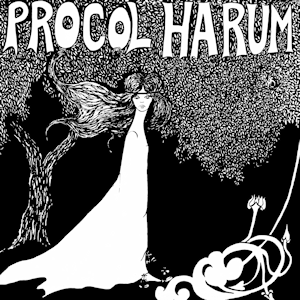Top Qs
Timeline
Chat
Perspective
Procol Harum (album)
1967 studio album by Procol Harum From Wikipedia, the free encyclopedia
Remove ads
Procol Harum is the debut studio album by the English rock band Procol Harum. It was released in September 1967 by record label Deram in the US, following their breakthrough and immensely popular single "A Whiter Shade of Pale". The track does not appear on the UK version of the album, but was included on the US issue. The UK version of the album was released in December 1967 by record label Regal Zonophone.
Remove ads
Writing
Summarize
Perspective
All songs were originally credited to Gary Brooker (music) and Keith Reid (lyrics), except "Repent Walpurgis" written by Matthew Fisher, after works by French organist Charles-Marie Widor and German composer Johann Sebastian Bach.
In 2005, Matthew Fisher filed suit in the Royal Courts of Justice against Gary Brooker and his publisher, claiming that Fisher co-wrote the music for "A Whiter Shade of Pale". On 30 July 2009, the House of Lords issued a final verdict on the case in Fisher's favour. A lower court had ruled in Fisher's favour in 2006, granting him co-writing credits and a share of the royalties. A higher court partly overturned the ruling in 2008, giving Fisher co-writing credit but no money. The Court of Appeal had previously held that Fisher had waited too long to bring his claim to court. The House of Lords disagreed, stating there was no time limitation for such claims. Lord David Neuberger of Abbotsbury's opinion stated: "Fisher's subsequent contribution was significant, and, especially the introductory eight bars, an important factor in the work's success...".[1][2]
Procol Harum's lyricist Keith Reid told Songfacts that the music for "Conquistador" was written before the lyrics. He added that this was unusual as "99 out of 100" of the Procol Harum songs, back then, "were written the words first, and then were set to music."[3]
Remove ads
Recording
The track "Salad Days (Are Here Again)" is credited as being from the film Separation.
Release
Summarize
Perspective
Procol Harum was released in September 1967 in the US, and in December 1967 in the UK. Though the album was recorded on multitrack, it was issued as mono-only in the UK, and in mono and rechannelled stereo in the US. Despite extensive searching, the original multitrack tapes have not been located and thus a stereo mix of the original ten tracks may never be possible. Several alternate takes, however, have been mixed into stereo and are available on CD. As recently as 2004, the original single, mixed to stereo, has appeared on a "Dick Bartley Presents: Classic Oldies" compilation on Eric Records.
The original North American release included a poster of the album cover. The artwork by Dickinson, the then-girlfriend, and subsequently wife of Keith Reid was heavily influenced by the style of the late-Victorian illustrator Aubrey Beardsley.[4]
The album has been repackaged and reissued many times. Two of the significant reissues are Procol Harum...Plus!, a 1998 CD compilation on the Westside label including all the songs from both the Deram and Regal Zonophone release, plus "Homburg" (the group's second single) and nine additional tracks from the period; and a monaural audiophile vinyl LP edition released in 2003 by Classic Records, with yet a different track order, including "Homburg" as the opening track and without "A Whiter Shade of Pale" or "Good Captain Clack". The set includes bonus singles of the original monaural and alternate stereo versions of "A Whiter Shade of Pale". A 2009 remaster by Salvo Records, using the original mono masters, was released, with bonus tracks including the singles "A Whiter Shade of Pale", "Homburg", B-sides and alternate stereo takes. However, many of the tracks are played at a higher speed. A 2015 remaster by Cherry Red Records expands the album into a 2-CD set.
A live version of the track "Conquistador", from the album Procol Harum Live with the Edmonton Symphony Orchestra, was released as a single in 1972 and charted to #16 in the US on the Billboard Hot 100 after 10 weeks on the chart.[5]
Remove ads
Reception
In his retrospective review of the album, Bruce Eder of AllMusic wrote: "Not everything here works, but it holds up better than most psychedelic or progressive rock." Melody Maker described the album as a "very pleasant and thoughtful set".[10]
Remove ads
Legacy
The album was included on Classic Rock magazine's list "50 Albums That Built Prog Rock".[11] It was included in Rolling Stone's 2007 list of "The 40 Essential Albums of 1967".[12]
In a major Tate Britain exhibition of the work of Aubrey Beardsley during 4 March – 25 May 2020, the Procol Harum album cover was shown alongside The Beatles Revolver artwork by Klaus Voormann to show how interest in Beardsley's monochrome pen-and-ink style was revived in the 1960s.
Remove ads
Track listing
Summarize
Perspective
All tracks are written by Gary Brooker and Keith Reid, except as noted.
US version
German version
2015 Esoteric Recordings 2-disc deluxe edition
Remove ads
Personnel
- Procol Harum
- Gary Brooker – vocals, piano
- Robin Trower – guitar (all but US 1)
- Matthew Fisher – hammond organ
- Dave Knights – bass
- B. J. Wilson – drums (all but US 1)
- Ray Royer – guitar (US 1)
- Keith Reid – lyrics
- Additional personnel
- Bill Eyden – drums (US 1)
- Technical
- Simon Platz – executive producer (for Fly Records)
- Eddy Offord, Frank Owen, Gerald Chevin, Keith Grant, Laurence Burridge – engineer
- Dickinson – front cover art
Remove ads
Charts
Certifications
Notes
- Two versions of this song were released—one with a "firm" ending, not a fade-out
- From the film Separation, 1968
References
External links
Wikiwand - on
Seamless Wikipedia browsing. On steroids.
Remove ads

